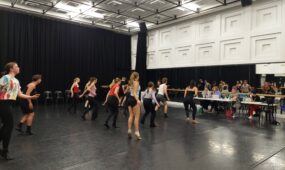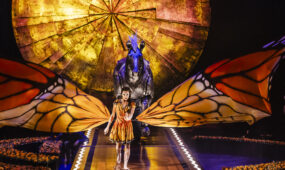Review: Restless Dance Theatre’s Seeing Through Darkness
Dance
For audiences starved of live performance for most of the year, Seeing Through Darkness is a show that makes the heart sing.

Restless Dance Theatre’s latest work was conceived by artistic director Michelle Ryan before the world had heard of COVID-19, yet the unfolding of the performance feels almost like a metaphor for life during the past seven or so months.
When it opens, the small performance space in the Art Gallery of South Australia is quite dark, with deep blue light falling on the six dancers huddled in the centre of a large circle.
As they lean in, slowly rolling their heads together and folding and unfolding their bodies, they appear like a single, shapeshifting, anguished form. It’s intense and intimate, seeming to echo the feelings many have experienced during lockdown.
Accompanied by an original score from local musicians Hilary Kleinig and Emily Tulloch, the dancers gradually move apart, with Ryan’s sensual and often playful choreography including several lovely duets, then becoming ever more loose and spirited as the lighting transitions to a more colourful spectrum enhanced by clever shadow-play.

Restless dancer Jianna Georgiou. Photo: Matt Byrnes
In the later part of the show, as the performers make full use of their bodies and the space, the impression is one of freedom and joy – and it’s reflected back from the audience of 10, who are reminded of all they have missed while deprived of live performance. The fact that we are on the same level as the dancers – in some cases, so close we could almost reach out and touch them – makes it all the more special.
Seeing Through Darkness was created by Ryan in response to a collection of works by expressionist artist Georges Rouault that caught her attention when she was invited to explore the Art Gallery of South Australia’s collection around five years ago.
Restless is a company that works with artists with and without disability, and she says the “imperfect form of the human body and the troubled soul of Rouault’s works” resonate with how people with disability can feel and be perceived: “Some may be confronted while others may see beauty in difference.”
Audience members attending the live performance in Gallery 10 of the AGSA walk first through an exhibition titled Chromatopia – a bold exploration of colour – before entering a smaller space hung with Rouault’s monochromatic portraits, where Ryan gives a personal introduction to the performance they are about to enjoy in the adjoining antechamber.
It’s a fully immersive experience, and in moments of near-stillness the dancers appear like visual artworks themselves. Integral to the show is the exquisite interplay of light and shadows, designed by Geoff Cobham and Meg Wilson and activated by a lighting track that runs along the edge of the performance space, painting the dancers and walls with colour.
The dancers themselves – Kathryn Adams, Chris Dyke, Jianna Georgiou, Michael Hodyl, Alexis Luke and Michael Noble – are all totally captivating throughout and show no signs of fatigue despite being three-quarters of the way through a sold-out season which has already seen them perform Seeing Through Darkness more than 30 times.
The show is another triumph for this award-winning Adelaide company that was cruelly stripped of its federal multi-year funding earlier this year, and while Seeing Through Darkness continues until October 2, it was already almost fully booked before the season began. If you missed out this time, make sure you book early for their next show.
Outside of performance times, visitors to the AGSA can view Seeing Through Darkness as a projection in Gallery 10 and get a taste of the light and shadow effects. Read SALIFE’s interview with Michelle Ryan about the work here.
Restless Dance Theatre’s Michelle Ryan and Michael Hodyl are also participants in Australian Dance Theatre collaboration The World’s Smallest Stage, which will be presented at the Odeon Theatre in Norwood on October 1 and 2.
Support local arts journalism
Your support will help us continue the important work of InReview in publishing free professional journalism that celebrates, interrogates and amplifies arts and culture in South Australia.
Donate Here



